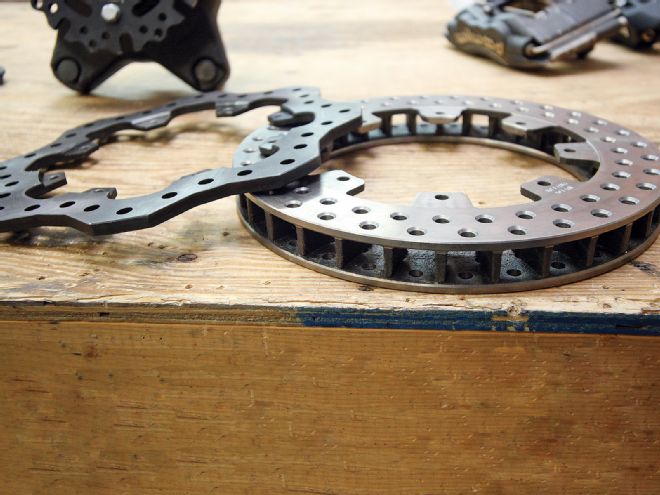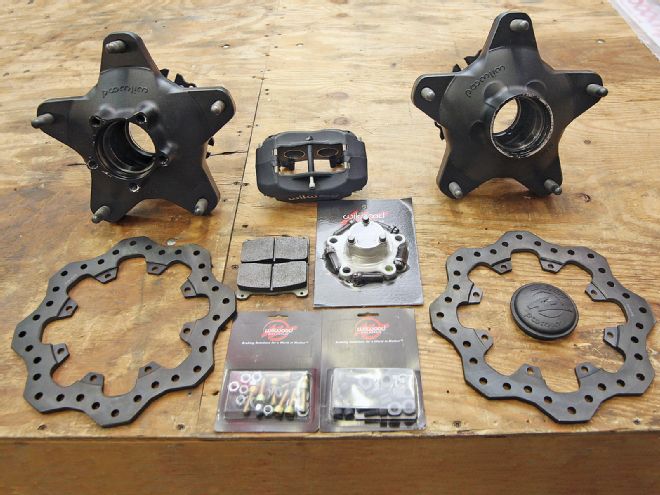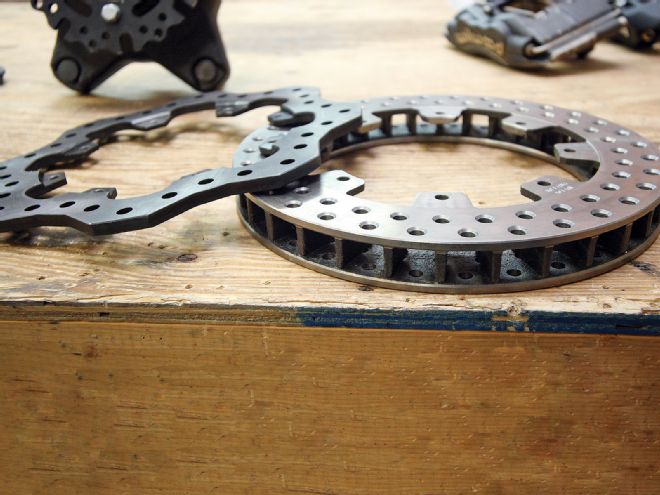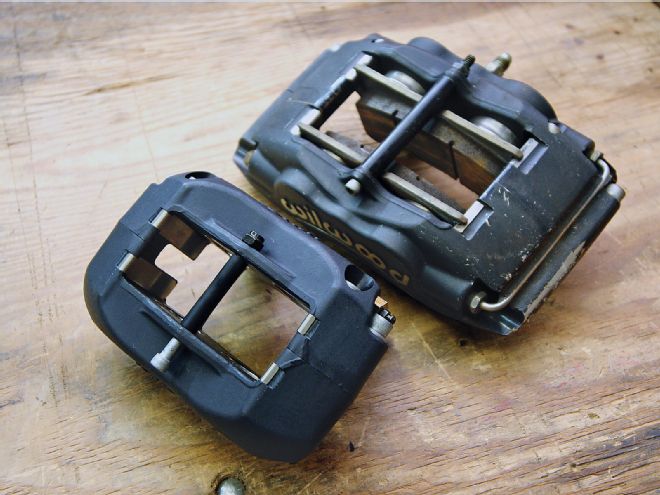
Racers are always trying to cut weight, even if they have to add it back in lead just to make the minimum weight. That's because placing the weight where you want it (low and to the left) can help the race car handle better.
But that's just static weight that the car has to haul around with it: bumpers, body, cylinder heads, that kind of stuff. Whenever you talk about cutting weight from any components that are part of the suspension you get a double whammy because cutting unsprung weight helps the suspension react more quickly. Cutting rotating weight—from areas like the crankshaft, clutch, and driveshaft—also has an extra benefit because it helps the engine spin up faster and get all that power to the rear tires.
Now consider hitting the magic trifecta where you can cut overall weight, unsprung weight, and rotating weight all at the same time. Usually, the only areas of a race car where you can get a triple threat like this are the hubs, brake rotors, axles, and gears. So every ounce you can cut there without sacrificing durability should play a very real role in improving your on-track performance.
Wilwood has engineered a way to cut big chunks of weight off a race car with it's drilled steel scalloped rotors. Steel rotors aren't exactly anything new. They've been around in drag racing and on Sprint Cars and motorcycles for years, but stock car racing has always been the domain of heavier cast-iron brake rotors. Compared to steel, cast-iron rotors are better at radiating heat and more durable than the lightweight steel units, and conventional thinking held that stock car racers are hard on the brakes two times a lap for 100 laps or more that beefy cast rotors are mandatory.
 Here’s the kit Wilwood’s “Spike” Logue helped spec out for our Limited Late Model dirt car to help significantly cut the rotating weight at each wheel. It includes four of Wilwood’s lightweight steel rotors; four of the company’s newly re-engineered Starlight 55-XD hubs; four narrowed brake calipers, pads, caps; and all the necessary mounting hardware.
Here’s the kit Wilwood’s “Spike” Logue helped spec out for our Limited Late Model dirt car to help significantly cut the rotating weight at each wheel. It includes four of Wilwood’s lightweight steel rotors; four of the company’s newly re-engineered Starlight 55-XD hubs; four narrowed brake calipers, pads, caps; and all the necessary mounting hardware.
But that isn't necessarily true. In horsepower-limited classes (which is practically anything with a crate engine today) it's easy to lug the engine. So the key to fast lap times becomes maintaining corner speeds. As a result, racers are trying to use less brake and can get by with smaller brake packages.
To see just how much could be gained, we worked with Wilwood to install a new, super-lightweight brake setup on a Limited Late Model dirt race car. A Limited car is a step above a Crate Late Model with a spec-head engine capable of nearly 700 horsepower. This much power, according to Wilwood's Jim "Spike" Logue who specializes in supporting short track racing teams, doesn't rule out a lightweight steel rotor system. In fact, he says he even has Super Dirt Late Model race teams running the system in the right situations.
"Horsepower really isn't a limiting factor," he explains. "The steel brakes are just as capable of slowing a race car as a cast-iron rotor. It's the diameter of the rotor and the clamping force of the caliper that determines that amount of wheel torque, or stopping power.
 1 This shot shows where the majority of our weight savings are coming from. On the bottom is one of the 11.75x1.250 drilled cast-iron rotors that came off the car. It weighs in at 7.7 pounds. On top of that is one of the scalloped lightweight steel rotors that’s the same diameter for equal clamping load, but just 0.38-inch thick. It weighs in at just 4.1 pounds. That’s a savings of nearly 14.5 pounds cut from the car in rotors alone!
1 This shot shows where the majority of our weight savings are coming from. On the bottom is one of the 11.75x1.250 drilled cast-iron rotors that came off the car. It weighs in at 7.7 pounds. On top of that is one of the scalloped lightweight steel rotors that’s the same diameter for equal clamping load, but just 0.38-inch thick. It weighs in at just 4.1 pounds. That’s a savings of nearly 14.5 pounds cut from the car in rotors alone!
"The difference is that a smaller rotor may save you weight, but it also isn't able to radiate off the heat generated from friction as efficiently. Normally, I say that these brakes excel in limited horsepower and crate applications. Momentum racing where you aren't extremely hard on the brakes. The rotor has two functions: The primary function is to convert clamping force into wheel torque to slow the car, but it's also the radiator of the brake system. Friction builds heat, and you have to move that heat away from the brakes or else the brake fluid boils and things stop working. Any time you take mass away from that rotor, you affect its ability to do its job. It isn't a matter of cast-iron versus steel, it's a matter of mass."
So how much weight can you save? Consider that the usual Wilwood vaned cast-iron rotor used by most Late Model level cars on both dirt and asphalt is 11.75 inches in diameter, 1.25 inches wide and weighs 8.8 pounds. A solid steel rotor that's still the same 11.75-inch diameter, but scalloped cuts the weight by more than half and weighs in at just 4.1 pounds. That's an incredible savings in terms of weight. But because it's just 0.38-inch wide, the weight savings also extend to the caliper, which doesn't need to be as wide, either. Altogether, we calculated a savings of approximately 5 pounds at each corner of the car, which came from swapping to the Wilwood steel rotors and corresponding calipers.
Speaking of calipers, Logue recommended outfitting the new calipers with the same Polymatrix B compound brake pads the racer was already used to with his existing setup. "The pads have the same friction against the steel rotors as cast-iron, but all pads have a different coefficient of friction as the temperature changes. As the pad gets hotter, it gets ‘grabbier.' That is until you hit a critical temperature, and then all the friction goes away.
 2 Because the rotor is so much narrower, the caliper can also be downsized. The Forged Narrow Dynalite calipers (foreground) are incredibly strong, feature internal crossovers, have the same four pistons as its larger Superlite cousin, while still managing to cut weight.
2 Because the rotor is so much narrower, the caliper can also be downsized. The Forged Narrow Dynalite calipers (foreground) are incredibly strong, feature internal crossovers, have the same four pistons as its larger Superlite cousin, while still managing to cut weight.
"So you may be able to start out with the same pad, but if you wind up running higher brake temps you may need to adjust your pad compound. Pad maintenance is also important because of the higher temperatures," he adds. "After a night of racing and you've been hard on the brakes, take the pads out, inspect them and scuff them up on the concrete to get rid of any glazing. If they look OK and you've got the glazing off, then they can go back in.
"Besides the pads, you also need to be very careful with your brake fluid. You probably already bleed the brakes regularly. But instead of just burping the bleeders to get any air out, bleed enough to get all the fluid out of the calipers and get fresh fluid in there. And you will probably have to bleed the brakes more often, too."
With the installation of the Wilwood braking system in this Limited Late Model dirt race car, we're looking forward to testing the system and will let you know how it goes. Stay tuned.
Instead of just burping the bleeders to get any air out, bleed enough to get all the fluid out of the calipers and get fresh fluid in there.